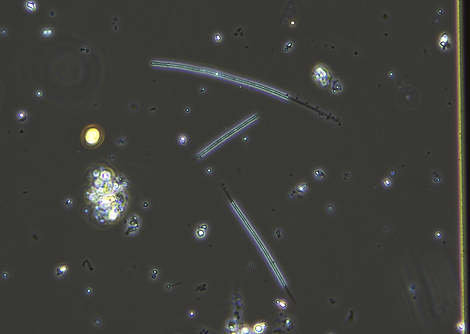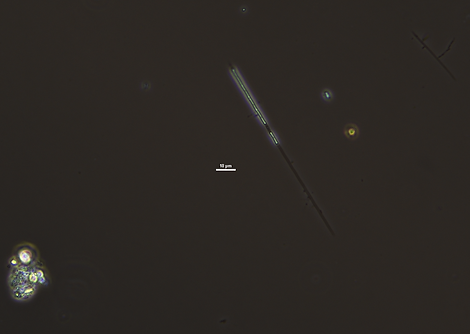Leptolygbya sp.
Key to Families
1. Cells growing to the original size of the mother cell before the next division.......................... 2
1: Cells not growing to the original size before division; divisions occurring in rapid succession............5
2. Trichomes fragmenting with necridia into motile hormogonia (1)............................................... PHORMIDIACEAE
2: Trichomes fragmenting usually without necridia............................................................................3
3. Trichomes with a widened sheath enveloping several to many trichomes (2:)............................ SCHIZOTRICHACEAE
3: Trichomes generally lacking a well-developed sheath, although thin delicate sheaths may be present in some genera.........4
4. Trichomes very short, usually few-celled, sometimes moniliform; cells isodiametric, broadly cylindrical to +-spherical (3:)..............BORZIACEAE
4: Trichomes usually more than a few cells long; cells cylindrical, +-isodiametric or mainly longer than wide........... PSEUDANABAENACEAE
5. Trichomes oval, arcuate or triangular in cross-section (1:)....................................... GOMONTIELLACEAE
5: Trichomes circular in cross-section......................................... OSCILLATORIACEAE
Key to genus
1. Trichomes heteropolar, always attached to the substratum at one end................... HETEROLEIBLEINIA
1: Trichomes isopolar, sometimes attached to the substratum along the length (or part) of the filament..........2
2. Trichomes regularly spirally coiled, without a sheath (1:)......... SPIRULINA
2: Trichomes straight, flexuous or variously coiled, with or without a sheath.......3
3. Trichomes planktonic, delicate; sheath extending beyond the trichome at both ends (2:)........ PLANKTOLYNGBYA
3: Trichomes benthic or metaphytic or planktonic; sheath, if present, not extending beyond the trichome at both ends.......4
4. Trichomes with or without a sheath (3:)............5
4: Trichomes always without a sheath...................6
5. Trichomes epiphytic, delicate, solitary, attached to the substratum along their entire length or with the ends free (4)...... LEIBLEINIA
5: Trichomes forming a tightly tangled mat............... LEPTOLYNGBYA
6. Cells clearly constricted at the cross-walls (4:)............7
6: Cells usually not constricted at the cross-walls...........8
7. Trichomes small, filamentous or pseudofilamentous, few-celled, arcuate or irregularly curved or coiled screw-like (6)..... ROMERIA
7: Trichomes solitary, generally straight; cells isodiametric or mainly longer than wide............. PSEUDANABAENA
8. Cells containing polar or central aerotopes (6:)............. LIMNOTHRIX
8: Cells without aerotopes.............9
9. Cell contents generally uniform, rarely with prominent granules (8:)................. JAAGINEMA
9: Cells containing large cyanophycin granules or conspicuous localised carotenoid bodies...... GEITLERINEMA
Key to Species
1. Cells +- isodiametric or shorter than broad............................2
1: Cells generally longer than broad...............................................6
2. Apical cells obtuse-conical; cells 1.2-3.0 x 0.9-3.0 um (1)........L. fragilis
2: Apical cells bluntly rounded
3. Central region of cells distinctly and densely granulated (2:)....Leptolyngbya sp.B
3: Cell contents uniform.....................................................................4
4. Trichomes 2.5-3.0 um wide (3:)............................................................L. cebennensis
4: Trichomes <2.5 um wide..................................................................5
5. Trichomes 1.5-2.4 um wide, very rarely pseudobranched (4:)...........L. foveloarum
5: Trichomes 1.5-2.0 um wide, often pseudobranched; pseudobranches generally thinner than the main filament........................................................................................L. boryana
6. Species from thermal habitats (1:)......................................................7
6: Species from various freshwater habitats.........................................9
7. Trichomes greenish red, or purple to brownish red; cells 2.0-4.5 (-6.0) x 1.5-2.7 um (6)...L. purpurascens
7: Trichomes pale blue-green to olive-green.......................................8
8. Cells (7.0-) 0.8-0.9 (-1.05) um wide (7:)...................................................L. circularis
8: Cells (1.4-) 1.6-1.7 (-1.9) um wide..............................................................L. tentaculiformis
9. Trichomes 3.3-3.5 um wide, prominently granulated on either side of the cross-walls (6:)...Leptolyngbya sp. A
9: Trichomes up to 3.0 um wide, without prominent granulations at the cross-walls....10
10. Trichomes (0.8-) 1.0-2.0 um wide, distinctly constricted at the cross-walls (9:).......L. tenuis
10: Trichomes 2.0-3.0 um wide, generally not constricted at the cross-walls........L. valderiana


Project
Perfect Execution
Project
A Real Success


Project
A Real Success
Project
Exceptional Achievement





